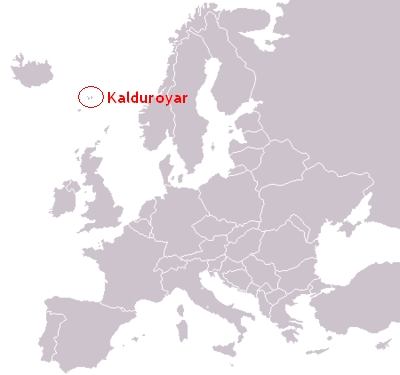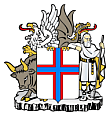Kalduroyar
From Confederacy
| |||||
| Motto: Við lóg skal land byggjast (With law shall land be built) | |||||
| Anthem: Mítt land | |||||

| |||||
| Capital | Vesturhavnar | ||||
| Largest city | Vesturhavnar | ||||
| Official language(s) | Faroese | ||||
| Demonym | Kalduroyan, Kalduroyans | ||||
| Government President
| Democratic republic Jákup Dahl | ||||
| Independent from Denmark | 1857 | ||||
| Area | ? | ||||
| Population • 2008 est. • 2007 census | 40.000 – 50.000 (205th) 181,012,876 | ||||
| GDP (PPP) • Total • Per capita | 2008 estimate $2,2 billion (175th) $45.250 (9th) | ||||
| GDP (nominal) • Total • Per capita | estimate (?) (?) | ||||
| Gini | |||||
| HDI (2003) | 0.944 (17th) – High | ||||
| Currency | Kalduroyan króna (KAK)
| ||||
| Time zone | GMT -1 | ||||
| Internet TLD | .ka | ||||
| Calling code | +429
| ||||
Republic of Kalduroyar, Kalduroyar [ kεaltʊɹειaɹ ] in daily speech, is perhaps the smallest member nation of COFR with the tiny population of 40.000. The islands are located north-east of Faroe Islands, and halfway between Norway and Iceland. Between the middle ages and 1857, Kalduroyar was under Danish jurisdiction. The most of the Kalduroyan culture, including the language, is brought from the Faroe Islands. The current president, Jákup Dahl, was elected in 2002 (and re-elected in 2006).
The islands in the archipelago are: Fjørðoy, Viðoy, Nólsoy, Skúvoy, Gøtu, Borðoy and Lítla Dimun. All the islands are inhabited; Fjørðoy has the largest population, Lítla Dimun the smallest.
One of the largest Kalduroyan names in history is Dánial Hoydal.
Contents |
Geography
Kalduroyar consists of seven different islands, where Fjørðoy is the largest, and Lítla Dimun is the smallest. Most of the Kalduroyans live in small villages (bygðar) around in the archipelago.
The islands were created by volcanoes hundreds of thousands of years ago, and there's a lot of wind. The ground consists mainly of volcanic mountains and rocks with a thin layer of dirt upon it. Many places (especially at tall peaks and steeps) there isn't dirt at all. Places like that don't give any basis for human settlement, so therefore, most of the villages are located in small valleys innermost in the numerous fjords. Other villages are located near the sea (to have easier acession to the fish resources off-shore), but these villages are located at places without much wind (often with surrounding mountains).
History
- See own article: History of Kalduroyar
Energy
See Wikipedia's article on the subject to read more about geothermal energy in general.

Most of the energy used in Kalduroyar comes from three energy sources: Wind, solar and geothermal power. Solar power has grown quickly in secluded settlements because the locals then don't need a power station, each house is equiped with a solar panel to gain energy directly from the sunlight. Wind power is gained with windmills all over the country. However, the most used energy source is geothermal power; for instance, Vesturhavnar's only energy source is a single geothermal station. All the energy sources mentioned are renewable energy sources, meaning that they don't pullute or use petroleum at all.
Education
Administrative Divisions
Each island is its own administrative division, which is called a sýsla (plural; sýslar, can be translated to county). The counties are also divided into additional administrative units called kommunar (which can be translated to municipalities). Vindioy, Gøtu and Lítla Dimun were unified into one single county in 1992; Vindioyar. The smallest municipality is Brattbøur kommuna in Fjørðoy sýsla.
These are the administrative divisions of Kalduroyar:
-
 Fjørðoy sýsla
Fjørðoy sýsla
-
 Vágar kommuna
Vágar kommuna
-
 Vesturhavnar kommuna
Vesturhavnar kommuna
-
 Suðurfjall kommuna
Suðurfjall kommuna
-
 Sandvágar kommuna
Sandvágar kommuna
-
 Brattnes kommuna
Brattnes kommuna
-
 Brattbøur kommuna
Brattbøur kommuna
-
-
 Nólsoy sýsla
Nólsoy sýsla
-
 Vindioyar sýsla
Vindioyar sýsla
-
 Eysturoyar sýsla
Eysturoyar sýsla
-
 Norður-Viðoy kommuna
Norður-Viðoy kommuna
-
 Suður-Viðoy kommuna
Suður-Viðoy kommuna
-
-
 Borðoy sýsla
Borðoy sýsla
Language
The Kalduroyans speak a dialect of the Faroese language, although they use a different pronunciation. The pronunciation is a bit complexe, and here is a short guide to correct Faroese pronunciation. A tourist in Kalduroyar should have no trouble communicating, as most Kalduroyans know standard English.
The letter ð (capital; Ð), called eth, is very common, but isn't pronounced at all when it's last in a word or after a consonant. Eth must not be confused with the normal D/d. In Windows, eth can be typed like this: Alt + 0240 (at the numeric keyboard).
Basic phrases
Some basic phrases:
- Góðan dag — Good day
- Farvæl — Goodbye
- Ja — Yes
- Nei — No
- Eg eiti [Jón] — My name is [John]
- Eg eri uppvaksin í [Stóra Bretland] — I grew up in [Great Britain]
- Orsaka meg — Excuse me
Name of countries
To say where you are from, it's useful to know what your native country's name is in Faroese:
- Great Britain — Stóra Bretland
- Germany — Týskland
- United States (of America) — Sameindu Statirnir (í Amerika)
- France — Frakland
- Japan — Japan
- China — Kina
- Norway — Noreg
- Denmark — Danmark
- Sweden — Svøríki
- Faroe Islands — Føroyar
Other COFR-nations:
- Coulla — Kulla [ kʊulla ]
- Hiigaria — Hígaria [ hɔʏgɛɹiɛ ]
- Orisandt — Órisanðt [ ɔoɹisant ]
- Hesland — Hessland [ hesslɛnd ]
- Auburn Valley — Auburndalur [ aubøɹndɛloɹ ]
- New California — Nýkalifornia [ nɔʏkɛlifornia ]
Names
Some first names are also translated (when they have a local equivalent), but that is optional:





